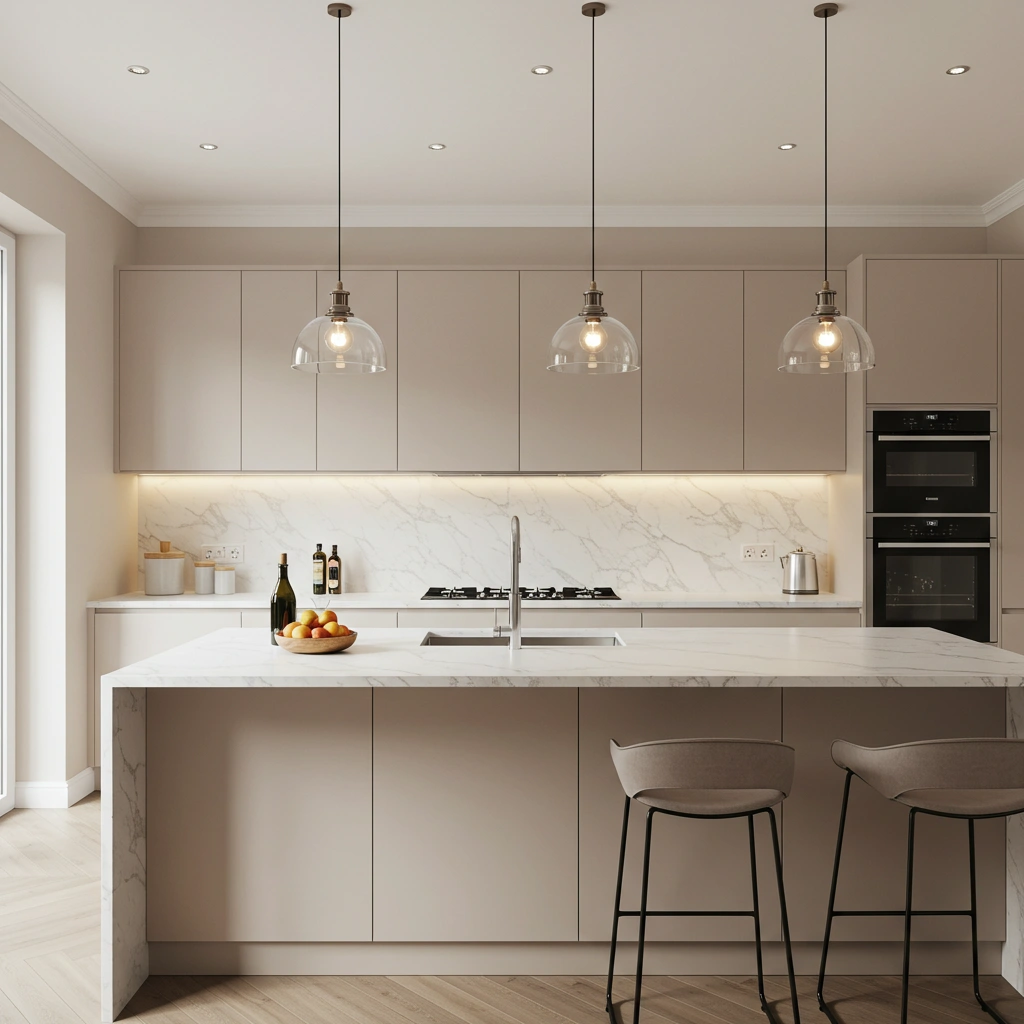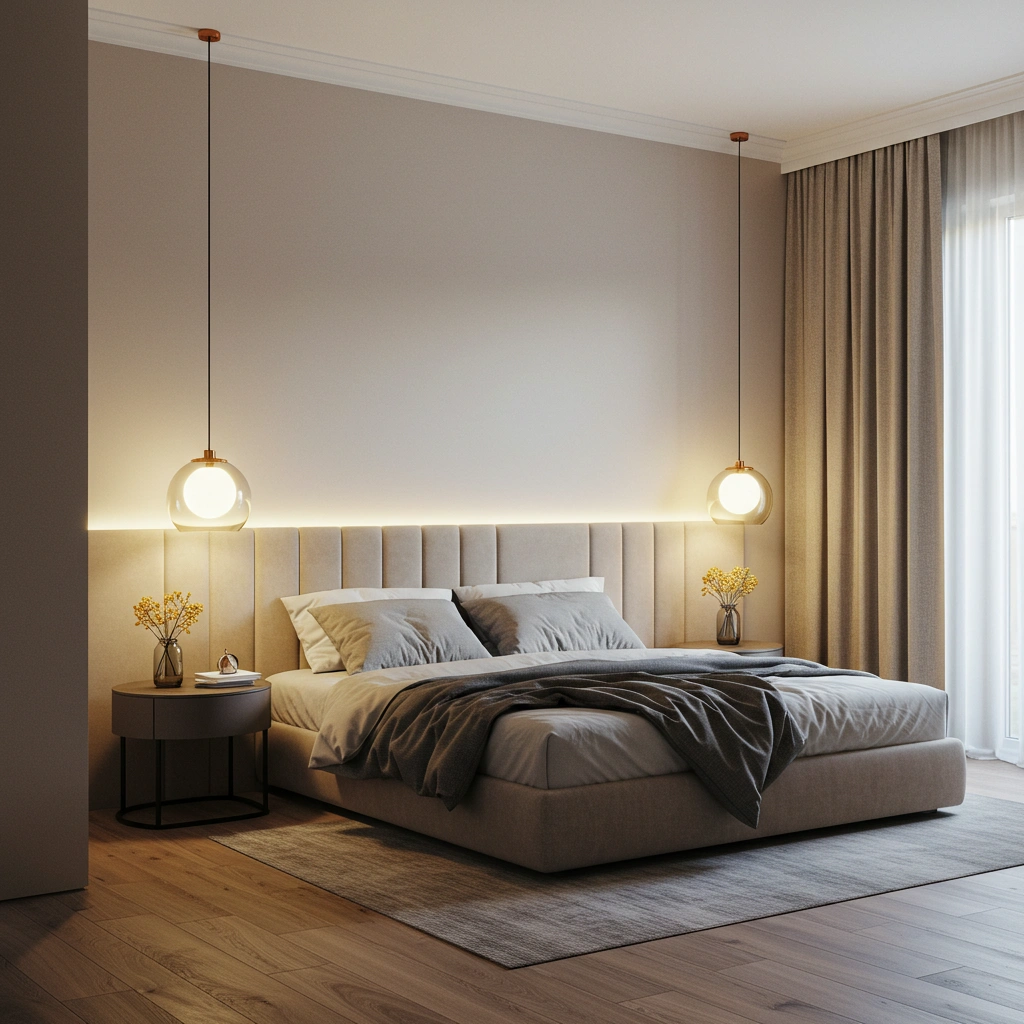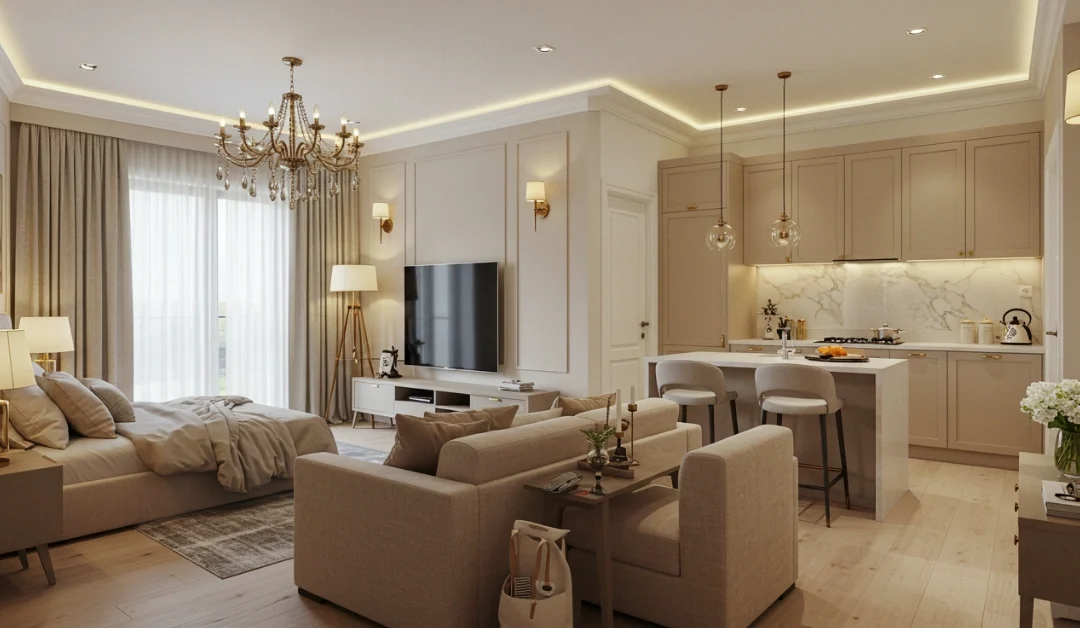Lighting is not a one-size-fits-all solution. Each room in a home is used for different activities, and this should be reflected in the lighting choices.
- Kitchens require bright, functional light to safely prepare food.
- Bedrooms need soft, relaxing light to encourage rest.
- Bathrooms benefit from clear, even light for tasks like shaving or applying makeup.
The way a room is used determines the type and placement of lighting. This ensures both safety and comfort in daily life.
1. What Are the Three Essential Layers of Lighting?
1. Ambient Lighting (Base Light)
This is the main light that fills the room. It is often provided by ceiling fixtures, recessed lights, or large lamps. Ambient lighting should be even and soft enough to avoid harsh shadows.
2. Task Lighting (Work Light)
Task lighting is used for specific jobs, such as reading, cooking, or working on a computer. Desk lamps, under-cabinet lights, and vanity mirrors are common examples. These lights should be focused and bright enough to reduce eye strain.
3. Accent Lighting (Decorative Light)
Accent lighting highlights artwork, architectural features, or other design elements. Small spotlights, LED strips, or decorative wall lights are often used for this purpose.
Using all three layers together creates a balanced and functional space.
2. What Is the Best Lighting for Kitchens?

Overhead Lighting
Ceiling-mounted fixtures or pendant lights are commonly installed above countertops and dining areas. These provide the main source of light for the kitchen.
Under-Cabinet LED Lights
These are mounted beneath upper cabinets and shine down onto the countertop. They are especially useful for cooking and cleaning.
Island and Dining Area Lights
If the kitchen includes an island or a dining table, pendant lights or chandeliers are often hung above these areas. This ensures good visibility during meals or social gatherings.
Color Temperature
- Warm white (2,700K–3,000K) creates a cozy and inviting atmosphere.
- Cool white (4,000K–5,000K) is better for task areas where clarity is needed.
A mix of warm and cool lighting can be used to match the mood and function of different parts of the kitchen.
3. What Kind of Lighting Is Best for Bedrooms?

Soft Lighting
Dimmable ceiling lights or warm-colored bulbs are often chosen to create a calming environment. Harsh overhead lights should be avoided in favor of softer options.
Bedside and Reading Lights
Small lamps placed on nightstands or wall-mounted sconces are ideal for reading in bed. These lights can be turned on and off independently of the main room light.
Dimmable Options
Dimmer switches allow the brightness of lights to be adjusted. This is useful for setting the right mood for relaxation or sleep.
No Overhead Lights?
If a bedroom lacks overhead lighting, floor lamps, table lamps, or string lights can be used to provide illumination without taking up much space.
For more ideas on how to decorate a bedroom, visit this guide to curtain colors for every room.
4. What Bathroom Lighting Ideas Work Best?
Vanity and Mirror Lights
Lights placed on either side of a mirror provide even illumination for tasks like shaving or applying makeup. Wall sconces or LED strips are popular choices for this purpose.
Shower and Bathtub Safety
Waterproof ceiling lights are often installed above showers or bathtubs. These lights are designed to be safe in wet environments.
Light Bulbs
- Cool white (3,000K–4,000K) is recommended for bathrooms, as it provides clear, bright light.
- Yellow or warm lights should be avoided, as they can distort skin tones.
Natural vs Artificial Light
If possible, windows or skylights should be used to bring natural light into the bathroom. If natural light is limited, artificial lights should be placed to mimic its effects.
5. What Living Room Lighting Ideas Create Ambiance?
Create Zones
Different areas of the living room can be lit separately. For example, floor lamps can be used near seating areas, while pendant lights can be placed over coffee tables.
Mix Fixtures
A combination of ceiling lights, floor lamps, and wall sconces can be used to create a layered look. This allows for flexibility in adjusting the lighting for different occasions.
Smart Lighting
Smart lights can be controlled using a smartphone app or voice assistant. These lights can be dimmed, brightened, or changed in color to match the mood of the room.
Natural Light
Mirrors and light-colored walls can be used to reflect natural light and make the room feel brighter.
For more ideas on how to style a living room, check out this comparison of modern sofas vs. Arabic majlis.
6. What Is the Best Lighting for a Home Office?
Reduce Eye Strain
A desk lamp with a cool white bulb (4,000K–5,000K) is often used to provide focused light for reading and writing. This helps reduce eye fatigue during long work hours.
Desk Lamps vs Overhead Lights
Desk lamps provide direct light on the workspace, while overhead lights illuminate the entire room. A combination of both is often the best solution.
Cool vs Warm Light
- Cool light is recommended for tasks that require concentration.
- Warm light can be used during breaks to help the eyes relax.
Long Work Hours
Flickering lights should be avoided, as they can cause headaches and eye strain. LED lights are a good choice because they provide steady, consistent illumination.
7. What Dining Room Lighting Options Work Well?
Chandeliers and Pendant Lights
These are commonly hung above dining tables to provide focused light for meals. The size and style of the light fixture should match the size and decor of the table.
Adjustable Lighting
Dimmer switches can be used to adjust the brightness of the lights for different occasions. This allows the same lighting to be used for both casual dinners and formal events.
Balance Style and Function
The light fixture should be both attractive and practical. It should provide enough light to see the food clearly while also enhancing the overall look of the room.
8. What Entryway and Hallway Lighting Ideas Are Practical?
First Impressions
A bright light near the front door helps create a welcoming atmosphere. This can be achieved with a decorative porch light or a wall-mounted fixture.
Motion Sensors
Motion-activated lights are often installed in entryways and hallways. These lights turn on automatically when movement is detected, making them both convenient and energy-efficient.
Space-Saving Fixtures
In narrow spaces like hallways, wall lights or small ceiling fixtures are preferred. These provide illumination without taking up much room.
9. Are Smart and Energy-Efficient Lights Worth It for Whole-House Use?
Voice-Controlled Lights
Smart lights can be controlled using voice commands through devices like Alexa or Google Assistant. This makes it easy to turn lights on and off without using switches.
Benefits of LED Lights
LED lights use less energy than traditional bulbs and last much longer. They are also available in a range of color temperatures, making them suitable for any room.
Smart Switches
Smart switches can be installed to control lights remotely. These switches can also be programmed to turn lights on or off at specific times.
Integration with Smart Home Systems
Smart lights can be connected to other devices, such as thermostats and security cameras, to create a fully automated home environment.
For more information on smart home technology, read this guide to roller blinds vs. Venetian vs. vertical blinds.
10. Final Thoughts: How Can I Light Up My Life One Room at a Time?
Choosing the right lighting for each room can make a big difference in how a home feels and functions. Start by thinking about how each space is used, and then select lights that match those needs.
For more home decor ideas, explore these related guides:
With the right lighting, any home can be transformed into a comfortable and stylish space.
11. Frequently Asked Questions About Home Lighting
Bright, layered lighting and the use of mirrors can make small rooms feel larger and more open.
Yes! Combining ambient, task, and accent lighting is the best way to create a functional and stylish space.
Warm light (2,700K–3,000K) is best for living rooms and bedrooms.
Cool light (4,000K–5,000K) is better for kitchens, bathrooms, and home offices.
Yes! Smart lights offer convenience, energy savings, and the ability to customize lighting for any occasion.
Bright lights, reflective surfaces, and natural light are the most effective at making a room feel spacious.

